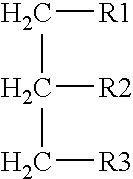Use of medium chain triglycerides for the treatment and prevention of Alzheimer's disease and other diseases resulting from reduced neuronal metabolism
a technology of triglyceride and medium chain triglyceride, which is applied in the direction of biocide, drug composition, metabolic disorder, etc., can solve the problems of drug not addressing the underlying pathology, no effective prevention or treatment exists, and additional cognitive functions become impaired, so as to reduce neuronal metabolism, reduce neuronal metabolism, and reduce neuronal metabolism
- Summary
- Abstract
- Description
- Claims
- Application Information
AI Technical Summary
Benefits of technology
Problems solved by technology
Method used
Image
Examples
example 1
Nutritional Drink
[0094] Nutritional drinks are prepared using the following ingredients: emulsified MCT 100 gr / drink, L-carnitine 1 gram / drink, mix of daily vitamins at recommended daily levels, and a variety of flavorings.
example 2
Additional Formulations
[0095] Additional formulations can be in the form of Ready to Drink Beverage, Powdered Beverages, Nutritional drinks, Food Bars, and the like. Formulations for such are clear to those skilled in the art.
[0096] A. Ready to Drink Beverage Ready to Drink Beverages are prepared using the following ingredients: emulsified MCT 5-100 g / drink, L-carnitine 250-1000 mg / drink, and a variety of flavorings and other ingredients used to increased palatability, stability, etc.
[0097] B. Powdered Beverages MCT may be prepared in a dried form, useful for food bars and powdered beverage preparations. A powdered beverage may be formed from the following components: dried emulsified MCT 10-50 g, L-carnitine 250-500 mg, sucrose 8-15 g, maltodextrin 1-5 g, flavorings 0-1 g.
[0098] C. Food bar A food bar would consist of: dried emulsified MCT 10-50 g, L-carnitine 250-500 mg, glycerin 1-5 g, corn syrup solids 5-25 g, cocoa 2-7 g, coating 15-25 g.
[0099] D. Gelatin Capsules Hard gel...
PUM
| Property | Measurement | Unit |
|---|---|---|
| Mass | aaaaa | aaaaa |
| Mass | aaaaa | aaaaa |
| Frequency | aaaaa | aaaaa |
Abstract
Description
Claims
Application Information
 Login to View More
Login to View More - R&D
- Intellectual Property
- Life Sciences
- Materials
- Tech Scout
- Unparalleled Data Quality
- Higher Quality Content
- 60% Fewer Hallucinations
Browse by: Latest US Patents, China's latest patents, Technical Efficacy Thesaurus, Application Domain, Technology Topic, Popular Technical Reports.
© 2025 PatSnap. All rights reserved.Legal|Privacy policy|Modern Slavery Act Transparency Statement|Sitemap|About US| Contact US: help@patsnap.com

